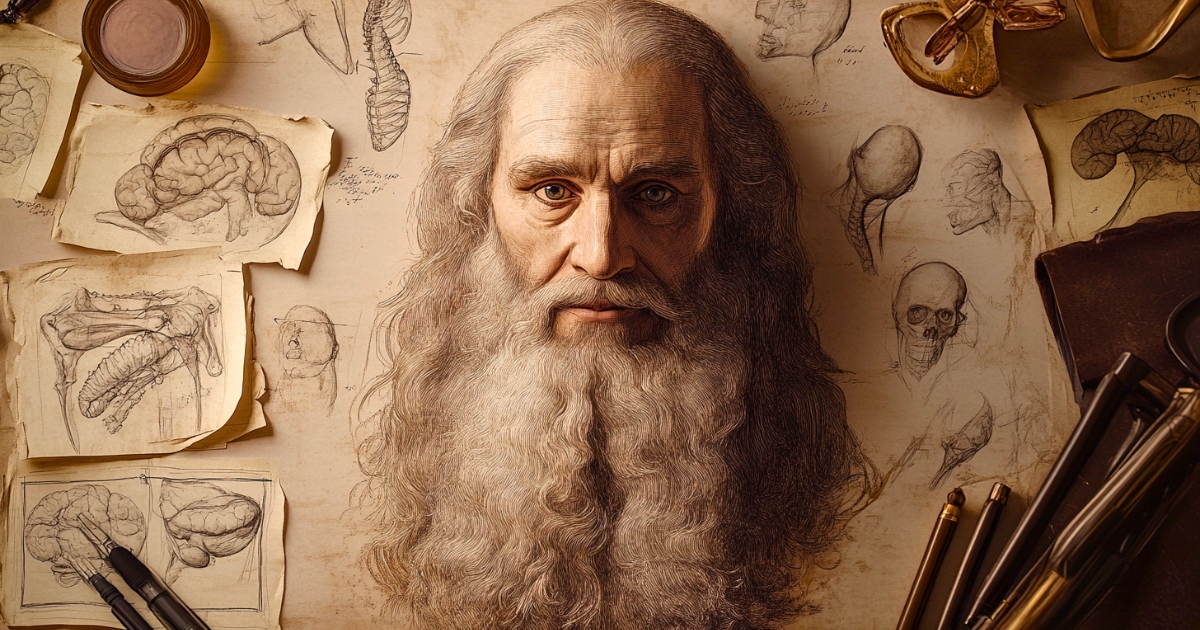Leonardo da Vinci (1452-1519) is renowned as one of the greatest artists of the Italian Renaissance. However, his talents extended far beyond art, encompassing science, engineering, and anatomy. His contributions to anatomy, in particular, demonstrated a foresight and precision that far surpassed the medical knowledge of his time. This article focuses on da Vinci’s anatomical studies, exploring their artistic and scientific value, and examining their impact on modern times.
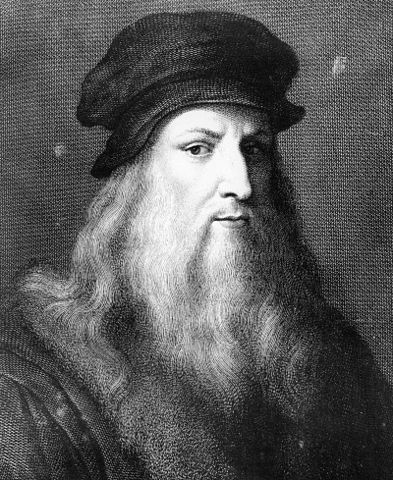
Portrait of Leonardo da Vinci. His long beard and piercing gaze reflect the intelligence and insight of both an artist and scientist.
Background of da Vinci’s Anatomical Research
Da Vinci’s interest in anatomy stemmed from his artistic curiosity. In his pursuit of accurate human depiction, he realized the importance of understanding not just surface appearance, but also internal structure.
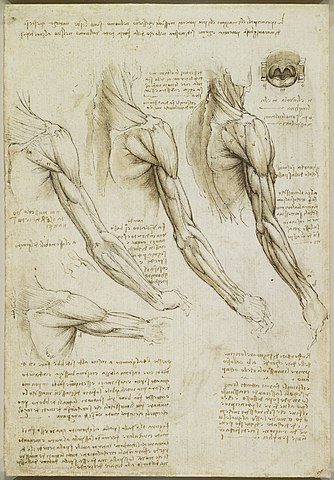
Leonardo da Vinci’s anatomical study of upper limb muscles. Note the precise depiction and detailed annotations. By Leonardo da Vinci
In the late 1480s, da Vinci was working at the Sforza court in Milan. This period marked the peak of the Renaissance in Milan, where the fusion of art and science was encouraged. Under the patronage of Ludovico Sforza, da Vinci was able to pursue his research freely.
Particularly significant was the influence of Marcantonio della Torre, an anatomist at the University of Milan. Della Torre questioned Galen’s classical medical theories and aimed to build new medical knowledge based on actual human dissections. While there’s no evidence of direct collaboration between da Vinci and della Torre, it’s likely they influenced each other’s research and ideas.
Inspired by this influence, da Vinci began his formal anatomical studies at the Santa Maria Nuova hospital, using his unique approach that combined an artist’s observational skills with a scientist’s inquisitive mind.
At the time, human dissection was severely restricted due to church opposition. However, da Vinci skillfully built relationships with physicians and authorities, gaining opportunities to perform dissections. His fame as an artist and the backing of the Sforza family made this challenging research possible.
His research method was highly systematic, involving repeated cycles of observation, recording, and reflection. Da Vinci created detailed sketches during dissections, accompanied by notes in mirror writing. These annotations included not only anatomical observations but also his unique insights into bodily functions and diseases.
Precision and Technique in Anatomical Illustrations
The precision of da Vinci’s anatomical drawings continues to astound modern medical professionals. His depictions of human muscles and skeletal structures, in particular, are remarkably accurate.
For instance, his cross-sectional drawings of the skull employed an innovative “cutaway” technique for the time. This method clearly revealed the skull’s internal structure, accurately depicting the brain’s position and shape. Similarly, his anatomical drawings of the heart accurately portrayed its four chambers and valve structures, demonstrating his insights into blood flow.
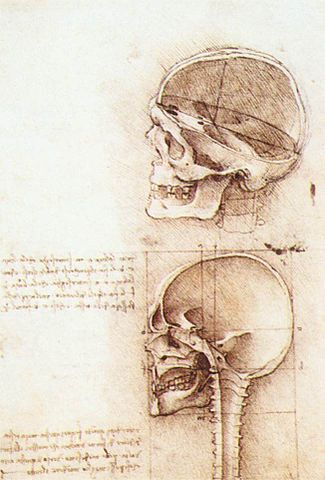
Da Vinci’s anatomical study of the skull. The upper image shows a cross-section of the top of the head, while the lower image depicts a vertical cross-section of the entire head. By Leonardo da Vinci
Da Vinci’s keen observational skills are also evident in his hand anatomy illustrations. He meticulously depicted the complex muscle structures and tendon arrangements of the hand, adding accurate observations about the mechanisms of hand movement. These drawings are so precise that modern orthopedic surgeons still refer to them.
A characteristic of his observational technique was to depict subjects from multiple viewpoints. For example, he would draw the same organ from different angles or show internal structures in layers, enabling a three-dimensional understanding. This approach can be seen as a precursor to modern 3D medical imaging.
Comparison with Contemporary Medicine
Renaissance-era medicine still heavily relied on Galen’s theories, which were primarily based on animal dissections and often differed from actual human anatomy.
In contrast, da Vinci’s research, based on direct human dissections, was far more accurate. For instance, he correctly depicted the curvature of the spine and the structure of the brain ventricles, aspects that were incorrectly described in medical texts of the time.
Particularly noteworthy is da Vinci’s research on the heart. He accurately drew the heart’s four chambers and made correct inferences about blood flow. This was about 100 years before William Harvey’s discovery of blood circulation.
Da Vinci also conducted fetal studies, leaving accurate observations about the position of the fetus in the uterus and the function of the umbilical cord. These insights far exceeded the standards of obstetrics at the time.
Furthermore, da Vinci focused on the relationship between anatomical structure and function. For example, he studied in detail the relationship between muscle attachment points and bone movement, attempting to understand the mechanisms of human motion. This approach forms the basis of modern exercise physiology.
Influence on His Art
Da Vinci’s anatomical studies profoundly influenced his artwork. This influence extends beyond accurate depiction of human figures to the expression of body movements and facial expressions.
In the “Mona Lisa,” his anatomical knowledge is applied to the subtle expression of facial features. The famous enigmatic smile, in particular, would have been impossible without his deep understanding of facial muscle movements. The posture and hand depiction of the model also reflect his knowledge of skeletal and muscular structures.
In “The Last Supper,” the diverse facial expressions and gestures of the characters are based on da Vinci’s profound understanding of human anatomy. Each figure’s posture and hand movements are not only anatomically accurate but also skillfully express their psychological states.
Moreover, the “Vitruvian Man” is a perfect fusion of da Vinci’s anatomical knowledge and artistic talent. This drawing visualizes the theory of ideal human proportions by the ancient Roman architect Vitruvius, beautifully expressed through da Vinci’s accurate human body depiction.
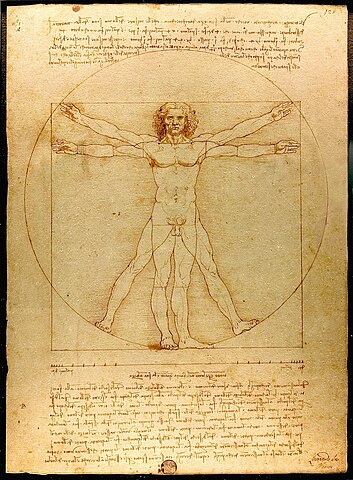
The Vitruvian Man. A masterpiece that combines da Vinci’s anatomical knowledge and artistic talent. By Leonardo da Vinci
Da Vinci’s anatomical studies also greatly influenced his sketches. His figure drawings go beyond mere external depiction, suggesting internal structures. The anatomical accuracy in muscle tension and joint movement gives his human figures a lifelike quality.
Impact on Modern Times
Although da Vinci’s anatomical studies were not published during his lifetime, their value is highly appreciated in the medical field today.
In modern medical education, da Vinci’s anatomical drawings are still used as important reference materials. His three-dimensional depiction method is particularly useful for modern medical students in understanding the three-dimensional structure of the human body.
Da Vinci’s research methods also provide insights for modern medical research. His cycle of observation, recording, and reflection can be seen as a precursor to modern scientific methodology. Furthermore, his approach of fusing art and science has greatly influenced the development of medical illustration and visualization techniques in medical education.
Notably, the development of the “da Vinci” surgical robot named after him is a prime example. This cutting-edge medical device embodies da Vinci’s spirit of precise observation and depiction in modern technology. The “da Vinci” robot accurately reproduces a surgeon’s hand movements, enabling intricate surgeries. This is a direct reflection of da Vinci’s understanding of the anatomical structure and function of the human hand in modern medical technology.
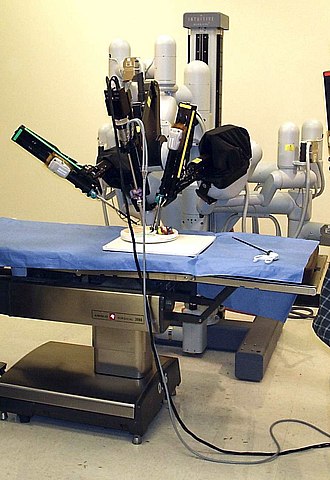
The modern ‘da Vinci’ surgical robot. This cutting-edge medical device named after da Vinci carries on his legacy. Nimur, CC BY-SA 3.0
Moreover, the 3D visualization techniques of da Vinci’s anatomical drawings have significantly influenced modern medical imaging. His multi-perspective depiction method forms the conceptual basis for 3D reconstruction techniques in modern CT scans and MRIs. For instance, da Vinci’s three-dimensional depiction of the heart has led to the creation of patient-specific heart models using 3D printing technology in modern cardiac surgery planning.
Furthermore, da Vinci’s research serves as an excellent example of the importance of integrating medicine and art, influencing modern medical education. Many medical schools now implement programs that incorporate art education, carrying on da Vinci’s spirit. For example, Harvard Medical School’s “Training the Eye” program aims to improve medical students’ diagnostic abilities through observational training in art museums.
Conclusion
Leonardo da Vinci’s anatomical studies were truly innovative achievements that transcended the boundaries of art and science. His precise observational skills, original depiction techniques, and deep insights far surpassed the medical knowledge of his time.
Da Vinci’s contributions to anatomy go beyond leaving accurate human body illustrations. He deeply contemplated the relationship between body structure and function, attempting to unravel the mysteries of life. This inquisitive spirit is what makes his research valuable beyond his era.
Today, da Vinci’s anatomical notes are highly valued not only for their medical significance but also as a symbol of the fusion of art and science. His research teaches us the importance of pursuing knowledge beyond the boundaries of specialized fields.
Da Vinci’s legacy continues to greatly influence modern medical education and research. His spirit lives on in new educational programs aiming to integrate medicine and art, and in the development of cutting-edge medical technologies. The “da Vinci” surgical robot and 3D medical imaging technologies are striking examples of how deeply rooted his innovative approach is in modern medicine.
Moreover, da Vinci’s interdisciplinary approach provides important insights for modern medical research. His studies demonstrate the need to integrate knowledge from various fields to understand complex life phenomena.
